Betta fish are very sensitive to changes in their environment.
Maintaining consistent water parameters is vital to the health of your fish.
But what are the ideal betta water parameters?
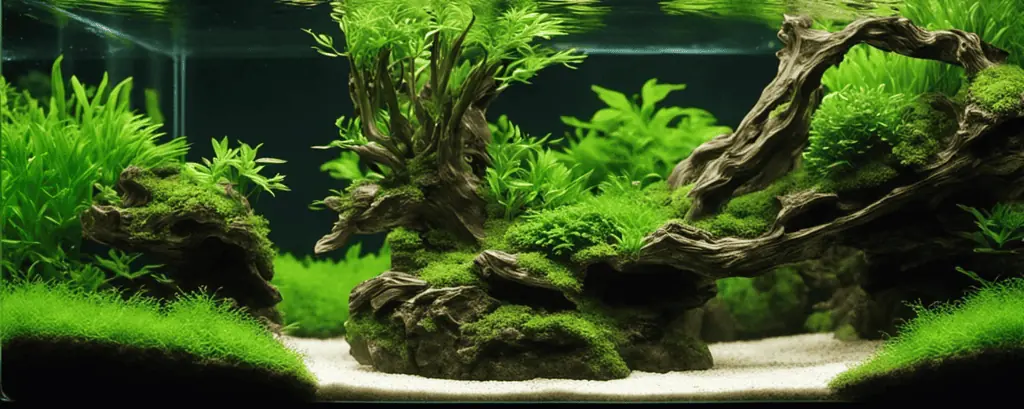
Table of Contents
Betta Water Parameters
Ideal Water Parameters for a Betta Fish Tank Include the following:
- Temperature: 78-80° degrees Fahrenheit (25.5-27° C)
- pH: 6.5-7.5
- Ammonia and Nitrite: 0 ppm
- Nitrate: < 40 ppm
- gH: 3-4 dGH (50-66.7 ppm)
- kH: 3-5 dKH (53.6-89.4 ppm)
- Minimum Tank Size: 5 Gallons
Betta fish water parameters are very specific. Straying too far outside of these parameters is harmful to your betta.
Weekly water changes and testing for toxic substances prevent these parameters from getting too far out of the best range for bettas.
Water temperature, tank size, and your filter’s flow rating are vital for recreating a betta’s natural environment.
Understanding the effects of each water parameter on your betta’s health allows you to create a safe environment for your fish.
Temperature
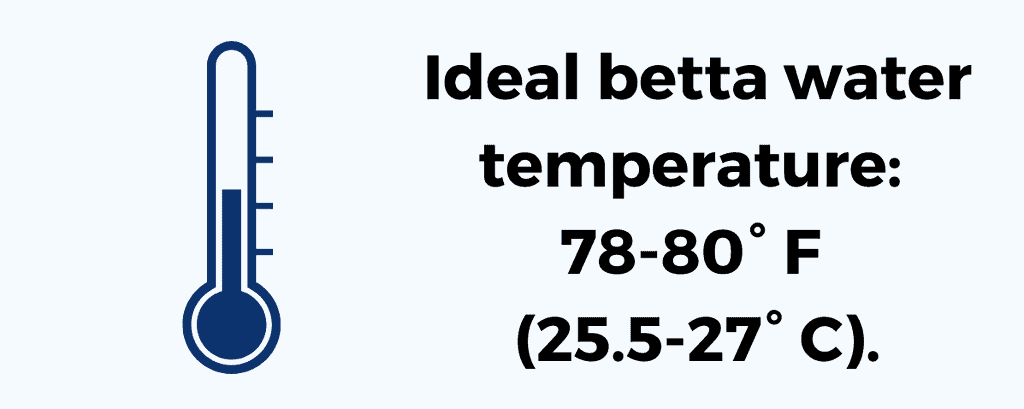
Bettas are tropical fish, so warm water temperatures are essential for their tank.
The ideal water temperatures for betta fish range from 78-80° degrees Fahrenheit (25.5-27° C).
Maintaining consistent water temperatures is crucial for a betta’s health. Temperature fluctuations are dangerous and are a common cause of illness in bettas.
When water temperatures are too hot in the tank, oxygen levels drop.
These lower oxygen levels will have your betta swimming to the surface and gasping for air.
Cold water temperatures prevent proper digestion.
This leads to lethargy, loss of appetite, and constipation in your betta.
Any of these combined symptoms increase your betta’s risk for swim bladder disease.
If the water temperature in your tank needs adjusting, you must do it gradually.
A sudden increase or decrease in water temperature will cause your betta to go into temperature shock.
Betta fish have difficulty recovering from temperature shock, which is often fatal.
Use an aquarium thermometer to check tank temperatures and ensure your heater is working.
The most critical time for temperature fluctuations is during a water change. Always be sure the water you add is the same temperature as the water inside the tank.
pH Levels

The pH of water refers to how acidic or alkaline it is. Ideal pH levels for a betta fish tank are between 6.5-7.5.
It is best to keep pH levels as consistent as possible to avoid harmful effects on your betta.
Acidic water causes burns, lesions, and erratic behavior in betta fish.
Alkaline water makes your betta prone to illness and encourages algae growth.
Several things affect the pH levels of aquarium water, including:
- The type of water used
- Substrate
- Urea from fish waste
- Food particles
- External sources (your hands, fish bags, decorations, etc.)
- Carbon dioxide from plants
Betta fish prefer a slightly acidic environment.
To lower basic pH levels, add a piece of driftwood or an Indian almond leaf to your tank.
Driftwood and Indian almond leaves release tannic acid to lower the pH in alkaline water.
Do not use both of these products simultaneously, or the pH may become too acidic.
As a rule of thumb, use only one Indian almond leaf per 10 gallons of water.
A side effect of tannic acid is it will turn your aquarium water brown. This brown color mimics the blackwater environment of a betta’s natural habitat.
Limestone rocks or coral sand leach calcium into the tank water to increase the pH.
Prevent sudden shifts in tank water pH by cleaning the tank to remove dead plants and waste products.
Add an air bubbler to increase oxygen levels and maintain a stable pH in the tank water.
Ammonia and Nitrite
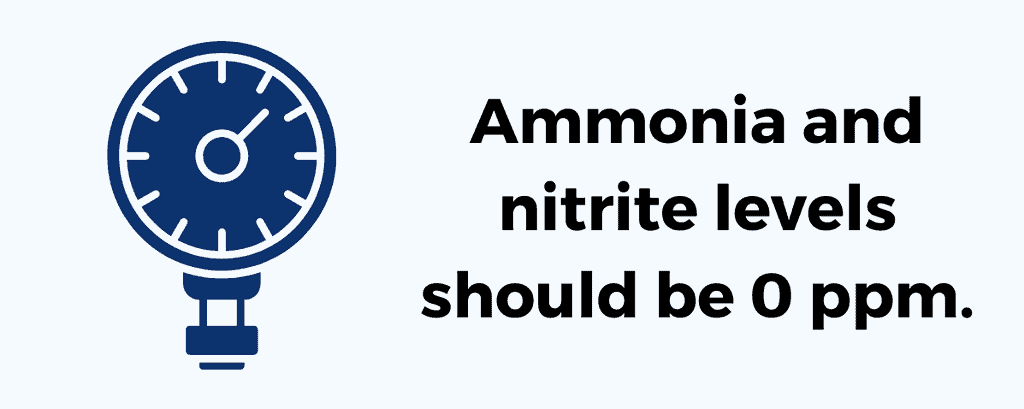
Ammonia and nitrite levels should always be 0 ppm (parts per million).
Even small amounts of these toxic substances are deadly for aquatic life.
Allow your tank to undergo a complete nitrogen cycle before adding your fish.
In a nitrogen cycle, beneficial bacteria break down ammonia into nitrite. As the cycle progresses, the nitrite converts into nitrate, which is less harmful.
These beneficial bacteria live in the filter media and substrate.
Let the tank go through a successful nitrogen cycle first.
This makes it much easier to control levels of ammonia and nitrite.
Preventing Ammonia and Nitrite Spikes

Ammonia enters the tank through fish waste and uneaten food.
Remove uneaten food within 30 minutes of feeding your betta.
Use a gravel vacuum to clean fish waste from the substrate.
Dead plants are also a source of ammonia in an aquarium. Getting rid of dead plants, uneaten food, and fish waste prevents ammonia spikes in your betta tank.
Partial water changes every week are also necessary to remove excess ammonia and other toxins.
Regular water testing is vital for measuring the amounts of toxic substances in your tank.
If ammonia and nitrite levels are above 0 ppm, your fish will suffer from poisoning. Symptoms of ammonia and nitrite poisoning in bettas include:
- Gasping for air
- A change in gill color
- Red streaks on the body and fins
- Inflammation of the eyes and anus
- Loss of appetite
- Lethargy
There is only one way to treat ammonia and nitrite poisoning in your betta.
It is to remove the toxic substance from the tank as quickly as possible.
Remove ammonia with frequent water changes and add nitrifying bacteria or an ammonia detoxifier. We have a post on simple methods to remove ammonia from your fish tank here.
Nitrate
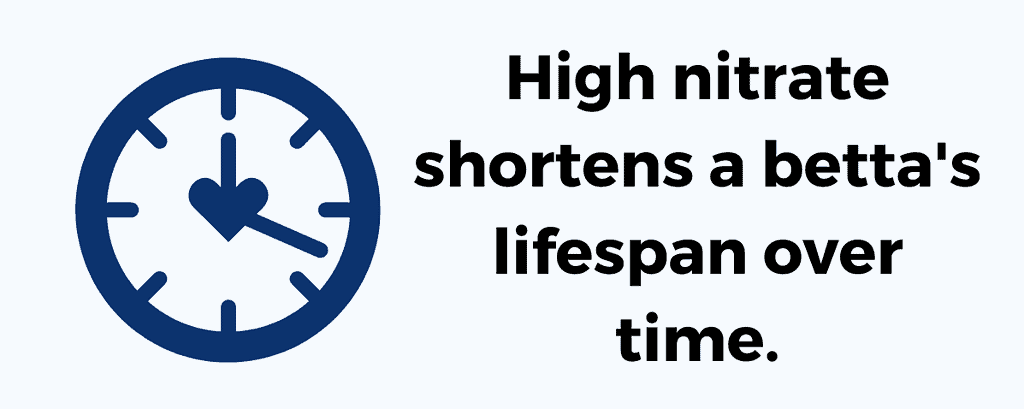
Nitrate is not completely harmless to betta fish but is not as deadly as ammonia or nitrite.
Traces of nitrate in an aquarium do not cause instant death but will shorten a betta’s lifespan over time.
The presence of nitrate is a sign the nitrogen cycle is doing its job. Beneficial bacteria formed in a nitrogen cycle convert ammonia to nitrite and then nitrite to nitrate.
The highest amount of nitrate allowable in a betta tank is a topic of great debate. Nitrate’s long-term effects on betta fish have not been studied.
Generally, safe nitrate levels in a betta tank are between 20-40 ppm.
In a planted tank, nitrate is usually not an issue because the plant life absorbs it.
Keep nitrate levels low with weekly partial water changes and regular cleaning.
General Hardness (GH) of Water

The general hardness, or GH, measures the amount of magnesium and calcium ions in water.
GH is usually measured in degrees, or dGH, ranging from 0-18. Low GH levels signify soft water, while high GH levels mean the water is hard.
Ideal GH levels for a betta tank are between 3-4 dGH or 50-66.7 ppm.
If your GH levels are very high, you may lower them with a commercial water softener or Indian almond leaves.
Carbonate Hardness (KH)
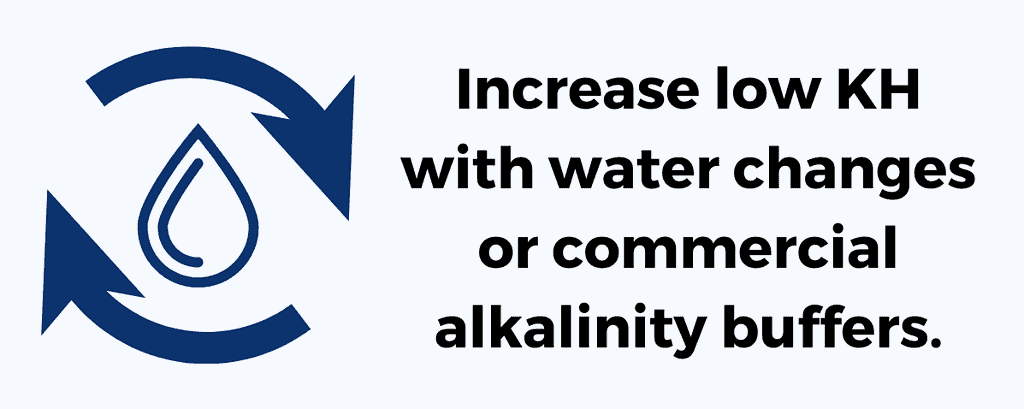
Carbonate hardness, or KH, measures aquarium water’s carbonate and bicarbonate ions. Higher levels of KH act as a buffer against fluctuations in pH.
When pH levels increase, the carbonate and bicarbonate ions release hydrogen ions to counter the effects.
KH is measured in degrees, or dKH, and parts per million.
The ideal levels of KH in a betta tank have a range of 3-5 dKH or 53.6-89.4 ppm.
KH levels do not directly affect your betta fish, but they keep your pH levels stable, which is good.
Increase low levels of KH with partial water changes or commercial alkalinity buffers. Natural alkalinity buffers include crushed coral, aragonite, and dolomite.
Keep in mind when you increase KH, the pH also increases.
If you struggle to lower the pH levels in your betta tank, you may also need to reduce KH levels.
To lower KH levels, mix in some reverse osmosis water or add a commercial acid buffer. You may also use natural acid buffers like Indian almond leaf or peat moss.
Minimum Tank Size
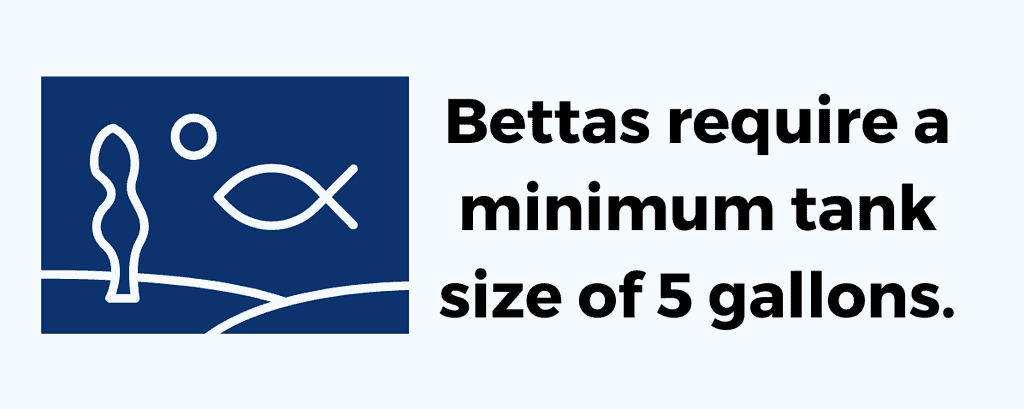
The size of your betta tank significantly influences maintaining proper water parameters.
Your betta requires a minimum tank size of 5 gallons. Completing a nitrogen cycle in anything smaller than 5 gallons is impossible.
Larger tanks also reduce the risk of ammonia spikes and pH fluctuations.
Avoid half-gallon tanks and “betta bowls” marketed to new betta fish owners.
Not only is it impossible to maintain correct water parameters, but these small setups do not give your betta adequate space to move.
Betta fish are active swimmers and much happier in a larger tank with plenty of plants and hiding places to explore.
If you plan to add tank mates like snails or small algae eaters with your betta, we recommend a 10 or 20-gallon tank.
Filter Flow Rating

Bettas prefer to live in calm waters, as their billowy fins often make swimming difficult in brisk currents.
A betta tank needs a filter to maintain beneficial bacteria and remove harmful toxins from the water.
When choosing a filter for your betta tank, look for one with adjustable flow settings. Adjustable filters allow you to create a gentle current for your betta by using the lowest setting.
Aquarium filters are rated by how many gallons per hour or GPH they can move. A filter must be capable of cycling all the water in the tank between 4-6 times per hour.
For a 5-gallon betta tank, choose a filter with a flow rate of 20-30 GPH. A 10-gallon tank requires a filter flow rate of 40-60 GPH.
If your betta spends a lot of time near the filter, it is likely to avoid the strong water current. Adjust your filter settings or use a baffle to slow the current.
For our full guide on everything you need to know about caring for betta fish, click the link to our article.
Maintaining Water for Betta Fish
You must take certain weekly steps to maintain the water parameters in your betta tank.
Neglecting tank maintenance puts your betta at risk for illness or death.
Following these steps keeps your betta healthy and ensures a safe living environment.
For those who prefer video, check this one out:

Testing Your Water Parameters
Test water parameters at least once per week.
It is always best to test the water following a partial change to keep the parameters stable.
Aquarium test strips are the most common method of checking water parameters and are easy to use. Dip a paper test strip in your tank water and use the color card to decipher the water parameters.
Test strips are a quick and easy way to check pH, nitrite, nitrate, GH, and KH levels.
The only downside to test strips is their accuracy. Using expired strips, touching them with wet fingers, or improper storage will render them inaccurate.
Use a water test kit with separate test tubes like this one for more reliable results.
Liquid tests include several bottles of testing solution and test tubes for more accurate measurements of:
- pH
- High-level pH
- Ammonia
- Nitrite
- Nitrate
To use this type of water test kit, fill the test tubes with tank water. Add a couple of drops of the appropriate solution, and compare the colors to the included test card.
If your tank parameters have been unstable, begin by testing for ammonia, nitrite, and nitrate before doing a water change. For mature and stable tanks, you may skip this step.
Weekly Water Changes for Bettas

Weekly water changes and testing for toxic substances prevent these parameters from getting too far out of the best range for bettas.
You only need to do a partial water change of 20-25% each week. Removing and adding too much water at one time crashes your nitrogen cycle and stresses your betta.
Only remove more water in an emergency situation.
To perform a water change, you will need the following:
- A length of hose
- Two buckets
- A siphon
- A test kit
- An algae scraper
- Water conditioner
- Towels to wipe up spills
Once you have gathered your supplies, turn off the heater and filter, and remove the tank lid.
You are now ready to begin the water change procedure.
Clean Substrate, Glass, and Decorations
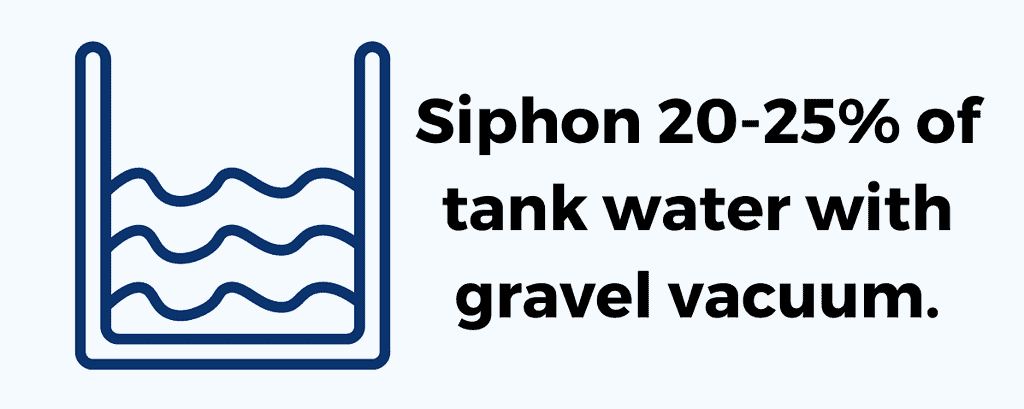
Use an algae scraper to clean the glass of your tank before removing any water.
You may use a magnetic aquarium scraper, a credit card, or a razor blade to remove the algae.
Use a gravel vacuum to siphon 20-25% of the tank water.
Using the vacuum to clean the aquarium gravel and tank decorations as you siphon the water.
The old tank water will go into one bucket.
Do not pour the water out yet, as you will need it in the next step.
To avoid cross-contamination, it is best to have two separate buckets for old and new tank water.
Rinse Out Filter Media in Tank Water
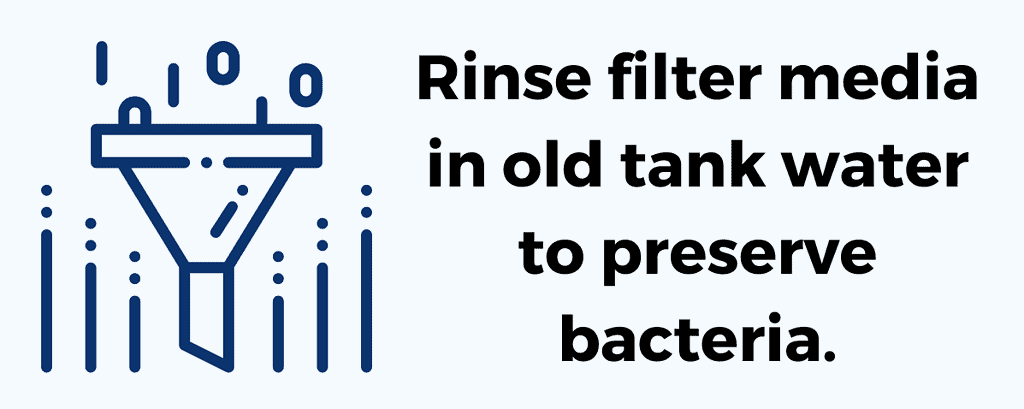
Remove filter media, such as cartridges or sponges, and rinse them out in the old tank water.
Rinsing the filter media in the old tank water ensures you do not disturb the beneficial bacteria created in the nitrogen cycle.
Never rinse your filter media in chlorinated water, or you will contaminate your betta tank.
Chlorine and chloramine are toxic to bettas, and exposure could be fatal.
Do not leave your filter media out of the water for too long. If the filter media dries out, the beneficial bacteria will be destroyed.
After rinsing the filter media, place it back in the tank.
Check the Pump for Debris
Now is also a good time to check the filter pump for debris.
Debris in your aquarium pump makes it less efficient.
Proceed with caution when cleaning the filter pump, as the small components are fragile.
Use a small toothbrush or aquarium tube brush to remove debris from the pump gently.
When you finish cleaning the pump, carefully reassemble it and place it back in the tank.
Refill the Tank
Fill the clean bucket with the same amount of water you removed from the tank, and add a water conditioner.
A water conditioner neutralizes chlorine and harmful metals and breaks down chloramine.
Chlorine and chloramine are usually added to tap water to kill bacteria.
These chlorine-based chemicals are safe for human consumption but toxic for bettas.
Ensure the new water is at the same temperature as the existing tank water to prevent temperature shock.
Once you have refilled the tank, turn on the heater and filter and replace the tank lid.
What Kind of Water for Betta Fish?
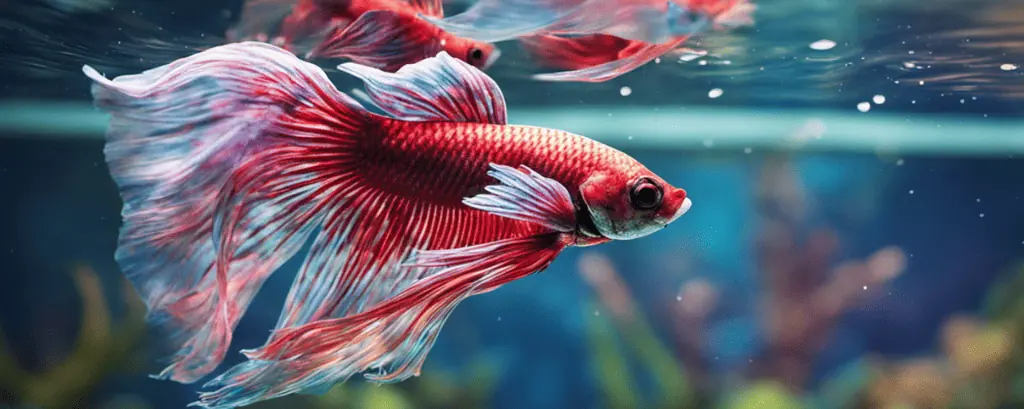
There are several water types you may use to fill your betta fish aquarium. But not every type of water is safe to use with your betta.
You must consider the properties of the most common water types listed below to determine which is best for your betta tank.
#1 Bottled Spring Water
Bottled water is usually filtered several times to ensure it is safe for human consumption.
Spring water contains important minerals bettas need and is considered safer than tap water.
But, the water may absorb traces of chemicals from the plastic bottle.
Add a water conditioner to bottled water to remove harmful chemicals.
Bottled spring water is safe to use in betta tanks. But, it becomes expensive when doing weekly water changes.
#2 Tap Water
Most betta fish owners fill their tanks with tap water treated with a water conditioner.
As noted before, chlorine-based chemicals are toxic to bettas and must be neutralized.
Follow the instructions on the bottle of water conditioner to add the correct amount.
Tap water is an excellent source for betta tanks because it is much cheaper than bottled water.
It is also easier to get the water to the correct temperature before adding it to the tank.
You may consider testing your tap water for pH levels and general hardness before using it in your betta tank.
Visit your local water company’s website for a report detailing potential contamination as well.
If your water is contaminated, use a filter with activated carbon and allow the water to filter for 24-48 hours.
#3 Well Water
Well water does not contain chlorine or chloramine but may contain pollutants from the water table.
Test your well water parameters for harmful chemicals or heavy metals.
Use the appropriate filter to remove chemicals, and add a water conditioner to bind copper, lead, and other heavy metals.
Since well water comes out of your tap, it is inexpensive to use for filling your betta tank and easy to control the temperature.
#4 Reverse Osmosis (RO) Water
Reverse osmosis water is filtered to remove all traces of chemicals and other toxic substances.
As a result, RO does not contain dissolved solids and maintains stable pH levels.
Despite how wonderful RO water seems, there are a couple of downsides.
RO water is very expensive due to the complex filtration process and lacks essential minerals your betta needs to stay healthy.
Before adding RO water to your betta tank, you must add these vital minerals.
Many fish owner mix RO water with treated tap water to ensure it contains the necessary minerals.
#5 Betta-Specific Water
Betta-specific water contains a water conditioner, and most pet stores sell it.
Experienced fish owners generally avoid betta-specific water. It is expensive and may contain chemicals from its plastic container.
Chemicals of any sort will harm your betta or ruin your nitrogen cycle. It is cheaper to use tap water treated with a water conditioner.
#6 Rainwater
There is some debate over whether rainwater is safe for bettas. Rainwater may contain pollutants and elevated nitrogen levels.
It is wise to test the parameters of rainwater before using it in your betta tank.
You may need to run it through a carbon filter to remove potential contaminants.
#7 Distilled Water
Distilled water contains no minerals, so it is not a good choice for a betta tank.
The only time it is safe to use distilled water is to lower the pH in your betta fish aquarium.
Final Thoughts on Betta Water Parameters
Consistent water parameters are the most important component of your aquarium’s ecosystem.
An aquarium test kit tells you everything you need to know about the water in your betta tank.
Weekly water changes allow you to stay on top of your water parameters before they become an issue for your betta fish.
It is not difficult to establish a regular tank cleaning routine, and your betta will be much healthier and happier as a result.


